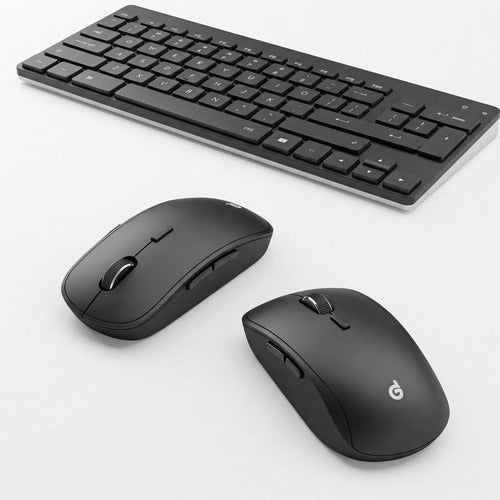Click and Clack Comfort: Essential Keyboards and Mice for Ergonomic Office Setups
In today's work-from-anywhere world, our desks have become our command centers. We spend hours typing, clicking, and navigating, often without giving a second thought to the tools beneath our fingertips. But neglecting ergonomics can lead to a cascade of discomfort, from wrist pain and carpal tunnel syndrome to neck and shoulder strain.
Investing in an ergonomic keyboard and mouse isn't a luxury – it's a vital step in prioritizing your well-being and boosting productivity. Choosing the right peripherals can make a world of difference in your daily comfort and long-term health. So, what should you look for when building an ergonomic office setup? Let's dive into the essentials.
The Keyboard: Your Typing Sanctuary
An ergonomic keyboard aims to minimize strain on your wrists and forearms by promoting a more natural typing posture. Here's what to consider:
- Split or Contoured Design: Traditional keyboards force your wrists to pronate (turn inwards), which can be a major source of discomfort. Split keyboards separate the key wells, allowing your hands to rest in a more natural, neutral position. Contoured keyboards take this a step further, often featuring a curved or dished design that further aligns with the natural shape of your hands.
- Negative Tilt: Many ergonomic keyboards offer the option to tilt away from you, rather than towards. This helps to keep your wrists in a neutral or slightly extended position, reducing strain during typing. Look for adjustable feet that allow for negative tilt.
- Low-Profile Keys: Keyboards with low-profile keys require less finger travel, which can reduce strain and fatigue, especially during long typing sessions.
- Tactile Feedback: While personal preference plays a role, keyboards with good tactile feedback allow you to type with less force, as you can feel when a key has been registered. This can contribute to a more comfortable and efficient typing experience.
- Compact Layouts: If you don't use the numeric keypad frequently, a tenkeyless (TKL) or compact keyboard can bring your mouse closer to your body's midline, reducing reaching and potential shoulder strain.
- Wireless Options: A wireless keyboard offers greater flexibility in positioning, allowing you to find the most comfortable setup without being restricted by cables.
The Mouse: Guiding Your Cursor with Comfort
Just like your keyboard, your mouse plays a significant role in your ergonomic comfort. Here's what to look for:
- Vertical Design: Traditional horizontal mice can force your forearm into a pronated position. Vertical mice allow your hand to rest in a more natural handshake position, reducing pressure on the wrist and forearm. This can be a game-changer for individuals experiencing wrist pain.
- Ergonomic Shape and Size: Choose a mouse that comfortably fits the size and shape of your hand. A mouse that's too large or too small can lead to awkward gripping and strain. Consider trying different sizes and shapes to find what feels best for you.
- Adjustable DPI (Dots Per Inch): Higher DPI settings mean the cursor moves further with less physical movement. This can reduce wrist strain, especially for tasks that require a lot of screen navigation. Look for a mouse that allows you to adjust the DPI to your preference.
- Programmable Buttons: Having programmable buttons can streamline your workflow by allowing you to assign frequently used shortcuts, reducing the need for repetitive mouse movements and keyboard presses.
- Wireless Options: Similar to keyboards, a wireless mouse offers greater freedom of movement and helps to declutter your workspace.
- Trackballs: For some individuals, trackballs can be a more ergonomic alternative to traditional mice. They require less wrist and forearm movement, as you control the cursor by rolling a ball with your thumb or fingers.
Beyond the Basics: Creating a Holistic Ergonomic Setup
While an ergonomic keyboard and mouse are crucial, they are just part of the puzzle. To create a truly comfortable and healthy workspace, consider these additional elements:
- Proper Desk Height: Your desk should allow your elbows to be bent at a 90-degree angle while your wrists are straight. Consider a standing desk or adjustable desk converter to switch between sitting and standing.
- Chair with Lumbar Support: A good ergonomic chair provides proper support for your lower back, promoting good posture.
- Monitor Position: Your monitor should be positioned at arm's length, with the top of the screen at or slightly below eye level. Consider using a monitor arm for optimal adjustability.
- Regular Breaks: No matter how ergonomic your setup is, taking regular breaks to stretch and move around is essential for preventing discomfort and fatigue.
Invest in Your Well-being, Invest in Ergonomics
Choosing the right ergonomic keyboard and mouse is an investment in your long-term comfort, health, and productivity. By paying attention to the design, features, and fit of your peripherals, you can create a workspace that supports your body and allows you to work comfortably and efficiently for years to come. Take the time to research and try out different options – your body will thank you for it!







